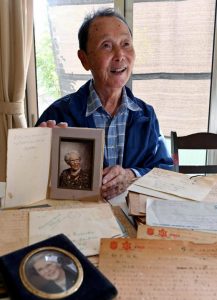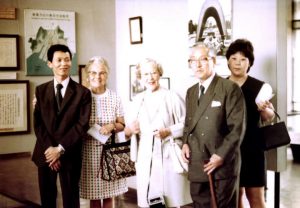A-bomb orphan appreciates “American mother,” who sent letters and visited Hiroshima, for giving him support to live
Aug. 5, 2023
Letter excerpts: ‘Happy to have good son in Japan’ — ‘Don’t lose sight of who you are even in hard times’
by Michiko Tanaka, Senior Staff Writer
Among the materials involving the Hiroshima Peace Center that have been found in Hiroshima City are numerous faded photographs that appear to have been taken in May 1973 at Peace Memorial Park, located in Hiroshima’s Naka Ward, and at a hotel on the island of Miyajima. The smiling young man standing next to an elderly Caucasian woman is Hiroshi Muraoka, 86, who lives in Hiroshima’s Minami Ward. “My American mother had come all the way to see me,” he said, smiling softly, as he had done 50 years previous.
His American “mother” was Grace Mesab, a former music teacher, although they were not related by blood. Ms. Mesab had participated in a so-called “moral adoption” campaign, which was designed to support A-bomb orphans who had lost parents in the atomic bombing. Ms. Mesab provided Mr. Muraoka with both material and emotional support. He has carefully held on to the pile of letters sent to him from the United States. “The fact there was someone thinking of me, even from far away, encouraged me to live. She aided in cultivating my spirit,” said Mr. Muraoka.
At the time of the atomic bombing, Mr. Muraoka was eight years old and living with his father. His parents had divorced when he was young. On August 6, he and his father experienced the bombing at his father’s workplace, a military footwear factory. Before he knew it, Mr. Muraoka found himself living on the streets around Hiroshima Station. He fought hunger every day. He dug in area fields for food, taking advantage of the darkness at night, and worked by polishing people’s shoes. In the winter, he would search for places to sleep while shivering from the cold.
In November 1946, he was picked up suddenly by a truck and, along with about a dozen other children around his age, taken to a Hiroshima Prefectural childcare facility for orphans on Ninoshima Island (now part of Hiroshima’s Minami Ward). He had not heard from his father, but when he was on the island a connection was formed with Ms. Mesab.
Mr. Muraoka still has the first letter from her, dated April 20, 1950, in which she wrote, “I am very happy for the news that I now have a good son in Japan. I think I can do what I would have done if I had a child of my own.”
It took him some time to respond to her letter because of his feelings of ambivalence toward Americans, who were once his “enemies.” However, the sincere words in the letters he received each week gradually altered his perception. Ms. Mesab’s letter dated August 10, 1950, reads, “Your first letter was the best gift I could have received.”
Mr. Muraoka later underwent vocational training to become a barber. He continued exchanging letters with Ms. Mesab even after he had left the orphanage. In his twenties he changed jobs frequently, but his American mother actively encouraged him. “Do not lose sight of who you are even in hard times,” she wrote. Sometimes money was enclosed within the letters.
When Mr. Muraoka opened his own barber shop in 1965, Ms. Mesab rejoiced at the news as if it were her own. Eight years later, she visited Japan to see him, at which time he introduced to her his wife, Mariko, now 79, and his three daughters.
Shigeto Yanagihara, secretary-general of the Hiroshima Peace Center who died in 1975 at the age of 75, was there when Ms. Mesab visited Japan. Mr. Muraoka is indebted to Mr. Yanagihara, who helped him maintain strong ties with Ms. Mesab by translating the letters exchanged between him and his mother for many years.
Mr. Muraoka received news of Ms. Mesab’s death around 1986. He continues to display her photograph at his home. “Someday, we’ll visit our grandmother’s grave in the United States,” explained her ‘grandchildren.’
With hopes for renunciation of war, Mr. Yanagihara supported exchanges between the citizens of Japan and the United States in the A-bombed city of Hiroshima. The seeds he planted have truly borne fruit after many years.
Keywords
Hiroshima Peace Center
Hiroshima Peace Center is an organization that was established in Hiroshima City in August 1950. Kiyoshi Tanimoto, an A-bomb survivor and priest at Hiroshima Nagarekawa Church who toured numerous places in the United States starting in 1948 to describe the horrific reality experienced by the people of Hiroshima, took the lead in establishing the center. In cooperation with organizations in the United States, the center promoted a “moral adoption” campaign to support A-bomb orphans and helped women A-bomb survivors travel to the United States for medical treatment. The center’s current focus is to publicly celebrate individuals and organizations that have contributed to peace. The materials involving the early days of the center, including letters and photographs, were discovered at the family home of the late Shigeto Yanagihara, former secretary-general of the organization.
(Originally published on August 5, 2023)









